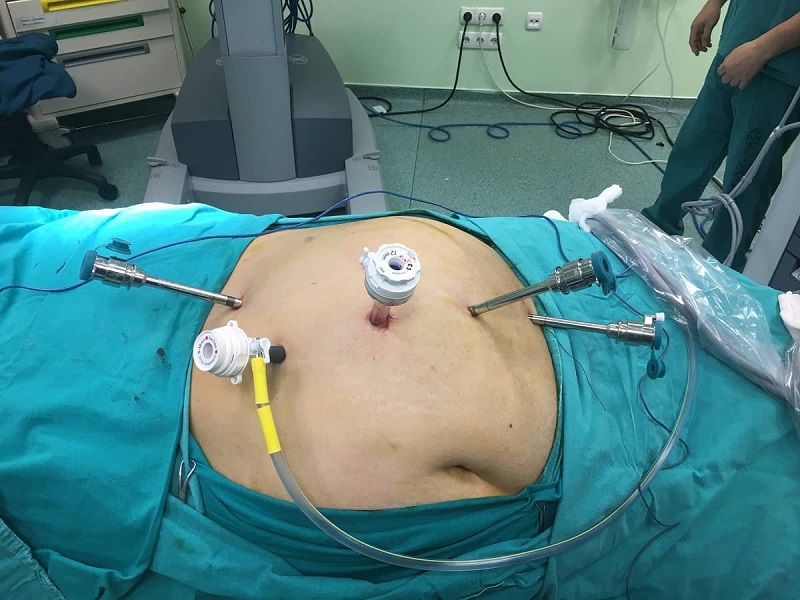
When performed with robotic surgery, bladder cancer surgery causes no bleeding. Robotic surgery is the most successful procedure among the surgical treatment options for bladder cancer options.
There are many advantages for both the patient and the surgeon in surgeries where da Vinci surgical robots are used. In treatments where surgical intervention is deemed necessary, it would be a great convenience for patients to prefer robotic surgery if possible.
In robotic-assisted bladder surgery, the muscles that ensure urinary continence are quite well preserved. Patients who want their sexual functions to be preserved to a great extent may prefer robotic surgery, as well.
What are the Advantages of Robotic Bladder Cancer Surgery?
The results of robotic bladder cancer surgery are excellent in many ways. Compared to classical open surgery, in particular, it has many advantages.
The advantages of robotic surgery in the treatment of bladder cancer can be listed as follows:
- No bleeding occurs during surgery.
- Neuroprotective surgeries that protect sexual functions are performed more easily.
- Since the procedure involves no incisions in the abdomen, the intestines do not come into contact with the external environment. In this way, the bowel movements return to normal faster after surgery.
- Compared to open surgery, it causes less postoperative pain.
- It provides quite satisfactory results in terms of aesthetic appearance.
- It allows for a very fast wound healing.
- The risk of infection it carries is minimal.
- It allows for returning to daily life faster.
The results after surgery are evaluated in 3 aspects.
- Oncological Results: Compared to open surgeries, robotic surgery provides 14% better removal of cancer.
- Consequences Relate to Urinary Incontinence: Daytime urinary incontinence is rarely experienced after robotic surgery. The probability of daytime urinary incontinence is approximately 4%. Urinary incontinence at night is a more important problem for people whose bladders have been removed. Approximately 20-30% of patients experience urinary incontinence at night.
- Consequences Related to Erectile Dysfunction: Erection functions can be maintained much better after robotic surgery.

How is Robotic Bladder Cancer Surgery Performed?
The surgical procedure performed using the da Vinci robotic system is called “robotic radical cystoprostatectomy + pelvic lymphadenectomy + orthotopic urinary diversion ”
The surgical procedure was performed under general anesthesia, through 6 holes made in the abdomen. Each of the holes is approximately 1 cm long.
6 trocars are placed in the patient’s navel through the holes, ensuring that they are positioned in such a way as to form lines parallel to each other. The arms of the robot are then attached to these trocars.

Trocar Placement in Robotic Surgery
The first step in the surgery is to clean the area between the bladder and the large intestine. If the patient is male and a neuroprotective surgery will be performed, the nerves are preserved in this stage.
Some of the blood vessels in the bladder are ligated. The tissues around the prostate are then gently separated. Finally, the urinary channels in front of the prostate are cut, and the bladder is placed in a bag.
If an artificial bladder is made for the patient, the operation takes 8 hours on average.
Second Stage
The lymph nodes around the iliac artery vessels next to the bladder are removed. The number of lymph nodes removed and the removal level of the lymph nodes are important.
Third Stage
In this stage; a bag is produced, to which the urinary canals from the kidney will be connected. When producing an artificial bladder, a part of about 45 cm in length is taken from the intestine, and then the remaining parts of the intestinal system are reconnected to each other.
The part of the bowel taken is properly cut and sutured in such as way as to create a bladder form. The urinary canals from the kidney are connected to this newly produced bladder.
The parts inside are then taken out from the vagina in women and through one of the trocar holes (after expanded) in men.
How is the Price of Robotic Bladder Cancer Surgery Determined?
Since the use of robotic surgery in the surgical treatment of bladder cancer gives very successful results, it has been very popular in recent years.
Some factors are taken into account when determining the price of a treatment to be performed with robotic surgery. These factors include the stage of cancer, the metastatic condition, the experience of the specialist surgeon who will perform the surgical operation, etc.
When determining an operation price, the procedures for the operating rooms determined by private hospitals are taken into account, as well.
Please contact us for more detailed information about robotic bladder cancer surgery and its prices.







